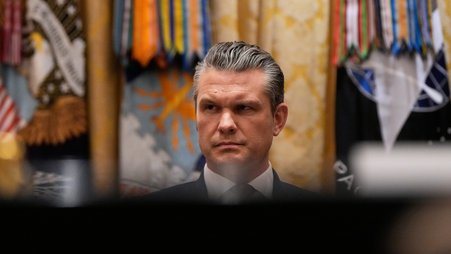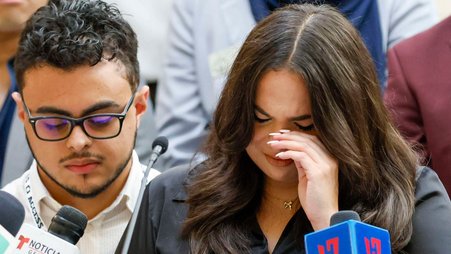
Plainfield High School student journalist Anu Nattam (center) holding the special edition of her school magazine the day of testifying in favor of Bill 1016
After a group of student journalists in Indiana published an issue of their high school magazine last October that focused on dating and relationships, the school implemented a policy of content review prior to publication. This, some students say, amounts to censorship that is compromising their journalistic education.
The October issue of Plainfield High School publication, the Quaker Shaker, was the magazine’s first “special topic” edition, called the Shakedown. It explored the ins and outs of relationships in high school, including polls about the prevalence of sexting as well as more serious topics like dating violence. It even won an award, which marked the first time the publication had won a national-level prize.
But parents and school administrators took issue with the content of the issue, particularly the sexting poll and use of urban dictionary definitions of words like “polyamory” and “friends with benefits.” In particular, one family member of the school board president blasted the publication on social media, encouraging people to complain to the school and school board president, and even asked why local churches were not rising up.
Now, student journalists at Plainfield need administrative approval to publish. As a result of this pushback, Plainfield High School journalism adviser Michelle Burress said that an advisory committee has been set up to evaluate every publication before it goes to press. The principal must approve anything before it is published.
To Anu Nattam, a co-editor of the publication, this policy shows that her school wants her magazine staff to act as a public relations team rather than journalists. Since the policy was implemented, she said that they were forced to change the name of their special edition issues to the Shakeout. Nattam said the school argued that the name Shakedown had mafia connotations.
“We’ve also had to change quotes, and delete quotes for trivial things that make no sense,” Nattam said. She also notes that they were asked to change the cover photo of one magazine issue because merely it showed a picture of a clothed posterior.
But it is her responsibility as a student journalist, Nattam said, to report on issues that are relevant to the student body, even if they might be controversial.
“Filtering reports and restricting ideas is not only an injustice to student journalists, but to the people reading the stories we write. Ideas and facts that impact a student body are not always going to make a school look good. Just like in real life, not everything is sunshine and rainbows.”
Nattam’s adviser Michelle Burress said that now, students are self-censoring, and worry about everything they write coming under intense scrutiny. “They are shying away from topics that normally they would not hesitate to cover because they do not want to get shot down,” she said. “More than ever this year, students are saying that they do not want to be quoted or pictured in the news magazine or yearbook.”
Ed Clere, a member of the Indiana House of Representatives, thinks this a huge problem. “Most people would have been proud to have student journalists who could produce work of that caliber,” he said of the Shakedown’s dating and relationships issue. Nothing the Plainfield High School student journalists have done or published, he said, has justified the censorship and “over the top” reaction that has ensued.
For two Indiana State Congress sessions, Clere has introduced legislation that would protect the free speech rights of student journalists across the state. It would have prohibited schools from encroaching on students’ speech rights except in very specific situations.
The bill reads: “This chapter may not be construed to authorize or protect content of school sponsored media by a student journalist that:(1) is libelous or slanderous; (2) violates federal or state law; (3) incites students to: (A) create a clear and present danger of the commission of an unlawful act; (B) violate a public school or school corporation policy; or (C) be disruptive of the operation of the public school; or (4) encourages, promotes, or supports behavior contrary to citizenship or moral instruction required under IC 20-30-5.”
House Bill 1016 was supported by many student journalists, including Anu Nattam, who testified in its favor, as well as teachers and administrators. But organizations including the Indiana School Boards Association and the Indiana Association of Public School Superintendents, fiercely opposed the bill. It died narrowly in the House on February 5, 2018.
Since a similar bill had failed the year before, Clere knew he was facing an uphill battle, but he was still surprised at the level of resistance and opposition the legislation encountered.
Clere cited a 1988 Supreme Court case that limited student publication freedom, Hazelwood School District v. Kuhlmeier, as a “big step backward” for the First Amendment rights of young journalists. “[School board superintendents and principals] like the absolute control they enjoy under Hazelwood. They don’t want to give it up.”
Indiana is far from the only state in which legislators, students, and teachers are fighting together to grant speech protections to student journalists. Clere said that efforts in Indiana are part of an initiative by the Student Press Law Center—a network, called New Voices, of state campaigns to pass such legislation.
Some states, including California, Montana, and Illinois, have successfully enacted New Voices legislation like Clere’s Bill 1016. But most states have not.
In Indiana, Clere isn’t giving up. Assuming he is re-elected, he vowed that he would “keep trying, and keep bringing this legislation back as long as I am able.” While he is open to discussion and addressing some of the concerns of school administrators, he said he is not open to watering down the bill to the point where it is meaningless.
“This is about more than journalism education and student publications,” Clere said. “Censorship of student journalists hurts entire school communities. It deprives them of the important and relevant stories and conversations that benefit all students.”
Nattam agrees. “People need to realize that by limiting press freedom for students, they are limiting their education. That’s what I feel like was done to me and my staff—our education was compromised, because we can’t be put in the same environment as a professional journalist. So, we can’t prepare for a career in journalism if that's what we choose to do.”
“If anything, this whole thing has fueled my passion for journalism,” Nattam said. “The press is how the public stays informed.”




